El Internacional, the First Postmodern Art Restaurant
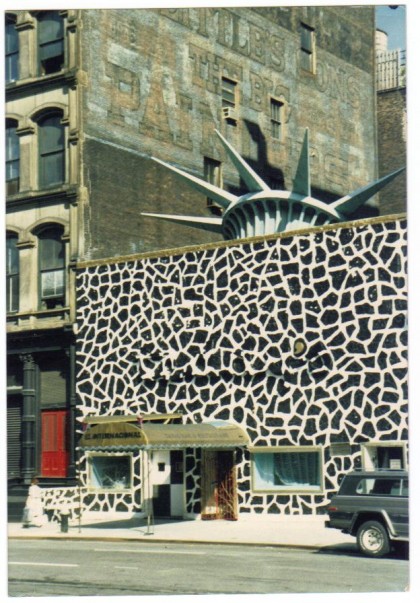 “I am the artist who did El Internacional, together with my partner, chef Montse Guillén, and all the rest of the team,” emailed artist Antoni Miralda, who goes by Miralda, last month. “We saw your great Scrapbook of Old Tribeca with the wonderful photos coming from different people. I am in Tribeca just this week and I would like to meet you to talk about a project we are working on about El Internacional.”
“I am the artist who did El Internacional, together with my partner, chef Montse Guillén, and all the rest of the team,” emailed artist Antoni Miralda, who goes by Miralda, last month. “We saw your great Scrapbook of Old Tribeca with the wonderful photos coming from different people. I am in Tribeca just this week and I would like to meet you to talk about a project we are working on about El Internacional.”
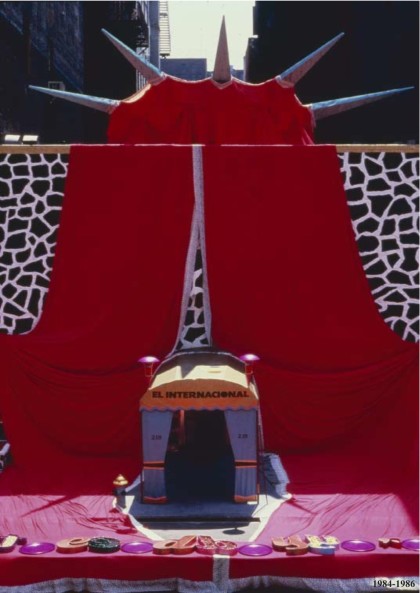 El Internacional opened in 1984, taking over an old-school Italian restaurant named Teddy’s—you can see “teddy’s” (and especially the apostrophe) camouflaged in the façade—at 219 W. Broadway, between White and Franklin. When he started work on the place, Miralda was delighted to discover exquisite mosaics under the drywall; inspired, he created what he called an “archaeological sandwich.” As Metropolis magazine put it, “What really makes this place interesting is the present layering of colors, materials and textures in a style that began in the fifties (with Teddy’s) and ended in an eighties version of the fifties style as El Internacional.” If Gordon Matta-Clark’s early 70s Soho restaurant Food was the first art restaurant, El Internacional was the first postmodern one.
El Internacional opened in 1984, taking over an old-school Italian restaurant named Teddy’s—you can see “teddy’s” (and especially the apostrophe) camouflaged in the façade—at 219 W. Broadway, between White and Franklin. When he started work on the place, Miralda was delighted to discover exquisite mosaics under the drywall; inspired, he created what he called an “archaeological sandwich.” As Metropolis magazine put it, “What really makes this place interesting is the present layering of colors, materials and textures in a style that began in the fifties (with Teddy’s) and ended in an eighties version of the fifties style as El Internacional.” If Gordon Matta-Clark’s early 70s Soho restaurant Food was the first art restaurant, El Internacional was the first postmodern one.
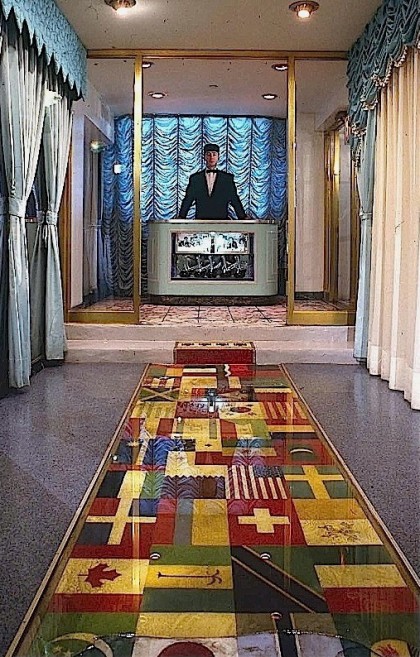 After it closed in 1986, the space was turned into El Teddy’s, and eventually the building was torn down and replaced by a new one (the storefront is occupied by Tribeca Paint). So I couldn’t resist suggesting Miralda and I meet at Box Kite Coffee, when it was popping up at Maslow 6. He lives in Barcelona and Miami, so I was sure he’d be amazed to see how much the block has changed.
After it closed in 1986, the space was turned into El Teddy’s, and eventually the building was torn down and replaced by a new one (the storefront is occupied by Tribeca Paint). So I couldn’t resist suggesting Miralda and I meet at Box Kite Coffee, when it was popping up at Maslow 6. He lives in Barcelona and Miami, so I was sure he’d be amazed to see how much the block has changed.
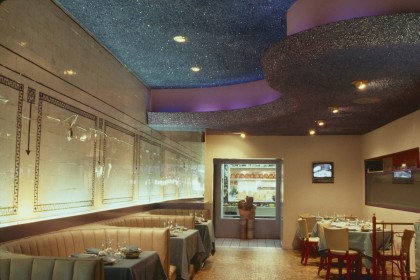 El Internacional’s façade itself was clearly a work of art, but there was much more inside, including a self-published newspaper handed out to patrons, the world’s first “Video Menu,” and events such as a Valentine’s Day celebration with 70 pairs of twins.
El Internacional’s façade itself was clearly a work of art, but there was much more inside, including a self-published newspaper handed out to patrons, the world’s first “Video Menu,” and events such as a Valentine’s Day celebration with 70 pairs of twins.
The Wikipedia entry says there were four theme rooms: “The Turquoise Dining Room which incorporated a wall of tiles, white, turquoise and gilt from the 20s found during refurbishment; the Carnation Room, a dining room in which the walls became an atlas of kisses where the diners would make the place their own by writing comments on the walls and leaving their kisses; the Sentimental Room with the video installation of images of the celebrities that frequented the golden era of Teddy’s: Elizabeth Taylor, Groucho Marx, Anthony Quinn, Sophia Loren, among others; and then, the Marina Room where four dried and salted cods presided over the dining room from the floor and the Sweet Ceiling was decorated with meringue-like stalactites. The wall that separated the Turquoise and Carnation Rooms was an aquarium from which visitors could see the Mermaid—brought back by Miralda from Bahia (Brazil)—representing Yemaya the goddess patron of the ocean and of motherhood.”
It became quite a scene. “Almost instantly, a motley conflux washed aboard,” wrote Gael Greene, New York magazine’s food critic at the time. “Sedate upper-crust Spaniards, raucous downtowners, artists from studios nearby (sculptor Donald Lipski, painters James De Woody and Julian Schnabel), and gawjus juntas dressed in evolved-after-therapy Annie Hall and vintage Pigalle, Since You Went Away chapeaux and Japanese bag-lady garb, tossing sturdy vinto tinto (the red wine of the house) down their throats from the juice glass or directly from the spout of the porron carafe.” Below: Jennifer Goode (of Area), Jean-Michel Basquiat, and pastry chef Antonio Buendia.
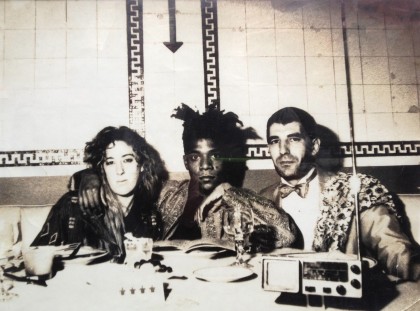 The food was not at all beside the point. El Internacional was possibly America’s first tapas restaurant. “So start at the bar, with delicately tender squid a la plancha, grilled sardines and shrimp (shrimp with their heads on, from Chinatown), the intoxicating eggplant, grilled mushrooms with a garlic kick, and that delicious tortilla,” wrote Greene about Montse Guillén’s food. “Best of all squid a la Romana, crisp as can be, deep-fried to perfection. Tooth-picks pry snails from their stylish striped shells to douse in a fiery hot sauce. There are tenderest grilled langoustines, cigalas in Spanish. Be sure to suck the juice and tiny bits of flesh that cling to the heads.”
The food was not at all beside the point. El Internacional was possibly America’s first tapas restaurant. “So start at the bar, with delicately tender squid a la plancha, grilled sardines and shrimp (shrimp with their heads on, from Chinatown), the intoxicating eggplant, grilled mushrooms with a garlic kick, and that delicious tortilla,” wrote Greene about Montse Guillén’s food. “Best of all squid a la Romana, crisp as can be, deep-fried to perfection. Tooth-picks pry snails from their stylish striped shells to douse in a fiery hot sauce. There are tenderest grilled langoustines, cigalas in Spanish. Be sure to suck the juice and tiny bits of flesh that cling to the heads.”
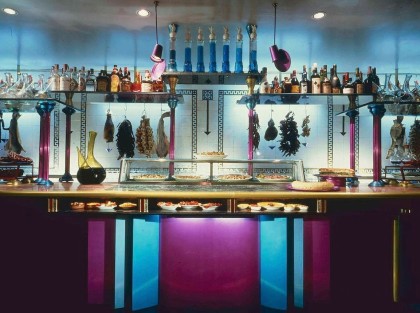 The project that Miralda mentioned in his initial email is a book—a loving look at a cutting-edge restaurant and a city in its creative heyday. Guillén and he have a trove of marvelous photos and memorabilia—I know, because I got to see much of it—but they could always use more. That’s where you come in: Do you have memories of El Internacional? Mementos? (Extra points for the whereabouts of the apostrophe from the “teddy’s” sign.) Please contact Miralda at miralda@foodcultura.org. And by all means pass this post along to anyone in the Tribeca disapora who might be able to help.
The project that Miralda mentioned in his initial email is a book—a loving look at a cutting-edge restaurant and a city in its creative heyday. Guillén and he have a trove of marvelous photos and memorabilia—I know, because I got to see much of it—but they could always use more. That’s where you come in: Do you have memories of El Internacional? Mementos? (Extra points for the whereabouts of the apostrophe from the “teddy’s” sign.) Please contact Miralda at miralda@foodcultura.org. And by all means pass this post along to anyone in the Tribeca disapora who might be able to help.
 Credits: The top photo of the façade is by Jose Morales; the façade draped for the crowning is by Pamela Duffy; the flag entrance and the Columbus Trophy Bar are by Peter Aaron; the Turquoise Dining Room is by Maria Sentis; the crown in the window is by JoAnne.
Credits: The top photo of the façade is by Jose Morales; the façade draped for the crowning is by Pamela Duffy; the flag entrance and the Columbus Trophy Bar are by Peter Aaron; the Turquoise Dining Room is by Maria Sentis; the crown in the window is by JoAnne.
Update: Comments have been turned off due to spam. To have them turned back on, email tribecacitizen@gmail.com.














The neighborhood fought so hard to keep this. Adam Gopnik wrote a piece in The New Yorker about it (in which he called me a real estate broker Saul Bellow might have invented). Rick Cook designed a perfectly respectable, buttoned-down building in its place. But it marked the end of the joyous Tribeca and the beginning of cashmere Tribeca. Do find Marjorie Strider, an artist who worked on the exterior of El Internacional.
Bruce, I have Strider’s address/phone # and email.
Here’s the New Yorker article Bruce mentions: http://www.newyorker.com/archive/2001/04/16/010416fa_FACT
There is certainly no joy in Tribeca anymore, only forced smiles obscured by cashmere scarves and wraps. Rats have been replaced by children. Why do we bother to live here? It should be called Mudville, not Tribeca. Too much?
Jim, Despite the ever changing names and personalities of neighborhoods; the city continues to beguile, beckon and bedazzle. In Huxley’s last words: “Never enough beauty”.
“Bedazzle” – is that the name of the strip club coming to the old Il Mattone space?